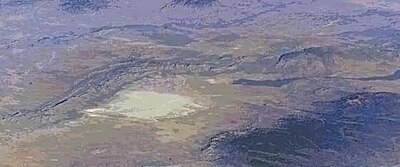Tularosa Basin
This article needs additional citations for verification. (May 2022) |


The Tularosa Basin is a graben basin in the Basin and Range Province and within the Chihuahuan Desert, east of the Rio Grande in southern New Mexico and West Texas, in the Southwestern United States.
Geography
The Tularosa Basin is located primarily in
Notable features of the basin include
Hydrologically, the Tularosa Basin is an endorheic basin, as no water flows out of it. The basin is closed to the north by Chupadera Mesa and to the south by the broad flat 4000-foot-elevation plain between the Franklin and Hueco Mountains, with the conventional boundary taken to be the New Mexico–Texas border. Surface water that does not evaporate or soak into the ground eventually accumulates at playas (intermittently dry lake beds), the largest of which is Lake Lucero, at 3888 feet elevation, at the southwest end of the White Sands dunes. The White Sands are a 710-km2 (275-mi2) field of white sand dunes composed of gypsum crystals. To the north of Lake Lucero are extensive alkali flats, which produce additional gypsum for wind deposition on the dunes.
History
The
- Apache, Spanish, and U.S. 'Old West'
When the Spanish arrived in the Tularosa Basin, they found springs and small streams coming from the

- Grasslands and grazing
The
- Groundwater salinization
Since surface water was unable to sustain the cattle herds, ranchers turned to groundwater, and the easily reachable aquifer of 'sweet water' was pumped out and depleted from under the basin, leaving only brackish water. Applying the groundwater to the surface resulted in additional salts being dissolved and transported back down by groundwater recharge into the aquifer, increasing its salinity. By 2000, it became clear that salts in the aquifer needed to be significantly reduced if existing levels of water use were to continue. Therefore, in 2004, the Tularosa Basin National Desalination Research Facility was established in the basin at Alamogordo, as a joint project of the Federal Bureau of Reclamation and Sandia National Laboratories. It is a national center for researching procedures to reduce brackish water creation and to develop new technologies for desalination as it is increasingly found in present-day inland basin aquifers with agricultural irrigation and potable water withdrawal demands.
Ecology
The Tularosa Basin is in the Chihuahuan Desert ecoregion, with the former Great Plains grassland habitat ecotones. Because of the closed nature of the basin, a number of unique ecological niches have developed. A significant number of endemic species are only found in the Tularosa Basin. These include the White Sands pupfish (Cyprinodon tularosa) and the Oscura Mountains chipmunk.
Counties
While the Tularosa Basin lies primarily in New Mexican Otero County, it also extends into Doña Ana, Sierra, Lincoln, and Socorro Counties in New Mexico, and El Paso County in southwest Texas.

Cities, towns, and ghost towns
- Alamogordo 32°54′N 105°58′W / 32.90°N 105.96°W
- Alvarado 32°05′N 106°08′W / 32.08°N 106.14°W
- Boles Acres 32°49′N 105°59′W / 32.81°N 105.99°W
- Carrizozo 33°38′N 105°53′W / 33.64°N 105.88°W
- Coane
- Desert 32°07′N 106°07′W / 32.12°N 106.11°W
- Elwood 32°11′N 106°05′W / 32.18°N 106.08°W
- Estey City
- Holloman AFB 32°49′N 105°56′W / 32.82°N 105.94°WZIP Code: 88330
- Kearney 32°59′N 105°59′W / 32.98°N 105.99°W
- La Luz 32°59′N 105°56′W / 32.98°N 105.94°W ZIP Code: 88337
- Lovelace 33°28′N 106°01′W / 33.46°N 106.02°W
- Monista 32°50′N 106°04′W / 32.83°N 106.07°W
- Omlee 32°50′N 105°58′W / 32.84°N 105.97°W
- Orogrande 32°22′N 106°05′W / 32.37°N 106.08°W ZIP Code: 88342
- Oscura
- Point of Sands
- Polly
- Salinas
- Three Rivers 33°19′N 106°04′W / 33.32°N 106.07°W ZIP Code: 88352
- Tularosa 33°04′N 106°01′W / 33.07°N 106.02°W ZIP Code: 88352
- Turquoise 32°27′N 106°02′W / 32.45°N 106.03°W
- Valmont 32°45′N 105°59′W / 32.75°N 105.99°W
- White Sands 32°23′N 106°29′W / 32.38°N 106.48°W
Notes
- ISSN 0190-8286. Retrieved 2023-10-27.
- ^ "The discovery of ancient human footprints in White Sands National Park and their link to abrupt climate change". United States Geological Survey. Earth Science Matters Newsletter. Retrieved 23 April 2022.
- ^ Tom Fraser in an interview in 1942, quoted in Sonnichsen, C.L. (1980) Tularosa: Last of the Frontier West Univ. of NM Press edition, p. 21.
